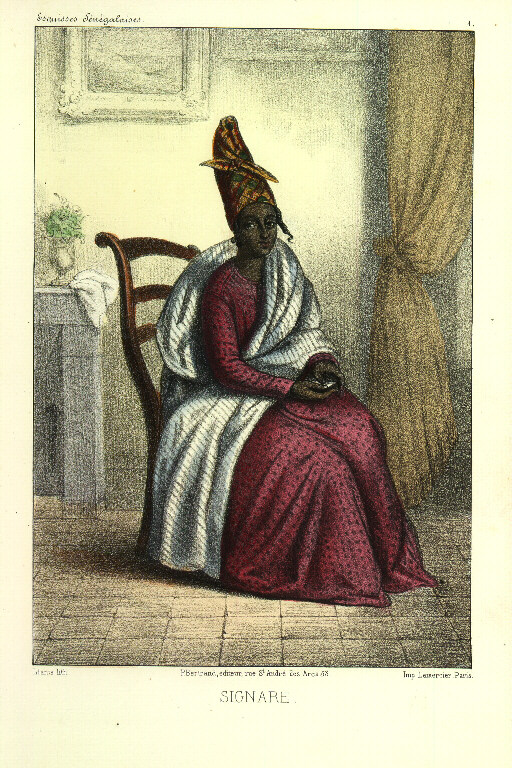| |
Signares
Young Métis / Creole Women From Senegal Africa during the very early Slave Trade
|
Ancestors to Many Haitian and Louisiana Creoles |
|
|
|
|
| |
|
|
| |
History
The first signares derive Portuguese Men and African Women . They were women from serer Petite Côte (Senegal) and at the beginning of the XVII e century Portuguese Union. These marriages were generally durable, because many of these Portuguese Men ended their lives in the counters they had created with the Serer and the King of the nearby Sine Saloum.
It is in these counters that métis children of these unions flourished, in particular the Signaras, the word meaning the "ladies" in Portuguese. These encounters, Joal, Saly-Portudal and Rufisco (rio fresco, fresh river) were governed by Signaras (Signares in French) and the Alquier (representing the King of the Sine). the Signares small coast economic system was based on leather Mfrg, cotton, indigo, gold and the spice trade.
The arrival of the France and England, transformed Senegal in a war zone, literally destroyed the first female micro-civilisation coast small and peaceful economic system, they had developed with their families Serer and Portuguese fathers (often of the Jewish faith).
The Signares emigrated from coast of Senegal to the islands of Gorée and St. Louis at the beginning of the XVIII e century the wars were triggered by the West Coast Kings of Senegal who sold the slaves in exchange for firearms, powder, ammunition, verroteries and pieces of Indian (pieces of fabric imported from India then manufactured in Rennes in the case of the France).
Gorée, the Signares invented "marriage of the country", i.e. a time limited recognized as valid by the King of France marriage and the Catholic Church. "Marriage of the country", political and economic nature, were reserved for rare meetings with Westerners. they represented no more than 15% of the unions.
The signares were strongly attached to the endogamous unions (80% of the unions)and only able to maintain their culture and preserve the accumulated capital from mother to daughter over several generations. Intermarriage with Westerners were elitist with aims to build strong social family networks in France and England and to strengthen their community of their Western relationships permanent protection against raw potential sent to Gorée by the administrations of these nations.

(of
|
|
|
|
The Signares never married simple sailors, but rather with bourgeois families or aristocratic French and English. The signares are not issues of marriage for African women slaves with Westerners but many marriages between women lébous serer and the West.
A ball of signares in St. Louis (engraving of 1890)
Stanislas de Boufflers, Governor of Senegal in 1785, Knight took as a companion the famous Anne Pépin, probably planned a meeting even before he was appointed to this position. Anna Colas Pépin, his niece, also possessed the current slave House (which was never constructed slave trading).
The signares succeeded in different time period by resisting freshly landed officers and governors who challenged their power and their privileges. Thanks to their family networks, they succeeded without penalty in infulencing the monarchic power in France as in England to counteract any decision destabilizing their way of life.
These mulâtresses rusées (Métis), commonly called Signares (rank qualifier and not color), were reputed for their haunting beauty and wealth, they did work skillfully. Between daily coquetry, Sunday holidays and maintenance of bustling small captive richly trimmed suites (slaves rescued from slave and integrated into the homes of the Signares), they led lives of femmes fatales, cultivating extreme sensuality.
Posterity
|
|
a gathering of European Men and Signares Women somewhere in Senegal Africa |
| |
|
|
| |
|
|
| |
|
|
| |
|
|
|
|
 |
 |
 |
 |
 |
 |
 |
 |
 |
 |
 |
 |
 |
 |
 |
 |
 |
 |
 |
 |
 |
 |
 |
 |
 |
 |
 |
 |
 |
 |
 |
 |
 |
| |
|
| 1. |
|
| 2. |
|
| 3. |
|
| 4. |
|
| 5. |
|
| 6. |
|
| 7. |
|
| 8. |
|
| 9. |
|
| 10. |
|
| 11. |
|
| 12. |
|
|
| |
|
